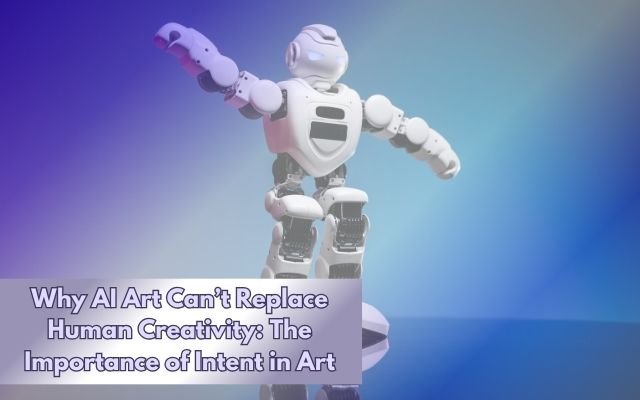Why AI Art Can’t Replace Human Creativity: Importance of Intent in Art
AI art is impressive, but it lacks the human intent that gives true art its meaning and emotional depth.

AI art is so advanced that it’s now competing with human artists and often creating stunning, detailed and beautiful images. However, there’s a big question: can art made by an algorithm ever feel as meaningful as something created by a human?
Human art is special because it reflects emotions, stories and personal experiences. When someone creates a painting or sculpture, it’s not just about how it looks—it’s about the intent and feelings behind it. This connection makes human art deeply personal and impactful.
However, AI lacks this human element. It will always use algorithms, statistics, and patterns, regardless of how skilled it gets at creating art. It is devoid of feelings, life experiences and ability to create with intention. The missing element that sets AI art apart and changes it is human purpose.
Even while AI art is technically stunning, it’s crucial to keep in mind that real art is more than simply pictures. It’s about the creation’s meaning which AI will never be able to replicate.
Why AI Art Stands Out?
AI art has advanced to the point where it took first place in the Colorado State Fair’s digital arts category in 2022. Beautiful, detailed images can be easily created using tools like MidJourney, DALL·E, and Stable Diffusion. AI can produce beautiful and intricate images in a matter of seconds with only a few lines of text.
It’s fascinating to see how AI blends styles, experiments with shapes & creates images that feel both familiar and unique. Beyond speed, it is also creative in ways that frequently beyond our expectations of a machine. Desire a golden-lit futuristic metropolis? Not an issue. Don’t you need a Renaissance-inspired surreal portrait? In a matter of seconds. It’s a genuinely amazing blend of quickness, originality and precision.
These works are beautiful to look at, yet they lack a deeper meaning. The beauty of AI art is merely superficial. A human aim and passion which are what give art its actual meaning, are missing beneath the well-polished pictures. Human art and AI inventions are inherently different from one another because of this.
Why Intent Matters?
What makes a piece of art truly special isn’t just how it looks—it’s the intent behind it. Intent is what drives human artists to create. It’s the story they want to tell, emotions they want to share or message they hope to communicate.
AI, no matter how advanced, doesn’t have intent. For example, when Jason Allen used MidJourney to create his award-winning piece, the AI didn’t decide what story to tell or what feelings to express. It just created the image by following directions and using data and patterns.
AI art is different from human creativity because it has no purpose. AI doesn’t feel or think, but it can create amazing images that might look like human art or make people feel something. Only people possess intent which is influenced by our objectives, past experiences and beliefs. Without it, meaning of AI art is less important than the process.
- Best Free AI Chatbots: My Experience Testing 9 Popular Options
- ChatGPT and Perplexity AI: Which AI Assistant Is Right for You?
- Why I Prefer Human Creativity Over AI for Personalized Content
Why Purpose is Important in Art?
Art that has intent is more than just aesthetically pleasing; it has purpose and aids in audience connection. Artists produce art for a purpose such as expressing feelings, narrating a tale or establishing a point.
For example, Picasso’s Guernica was created to show the horrors of war after the bombing of a Spanish town. Its purpose makes it powerful and emotional. Without that intent, it wouldn’t have the same impact.
AI can create images that look like Guernica, but it doesn’t have emotions, purpose or context. This is why AI art can’t match the deeper connection of human-created art.
FAQ
1. Can AI art ever truly replace human-created art?
While AI art can produce visually stunning and intricate creations, it lacks the emotional depth, personal experiences, and intent that define human art. Human creativity connects deeply with audiences by telling stories, evoking emotions and conveying purpose, making it irreplaceable.
2. Why is intent important in art?
Intent gives art its meaning and purpose. It reflects the artist’s emotions, beliefs and experiences, creating a connection with the audience. AI, however advanced, does not possess intent; it only follows algorithms to generate images.
3. Can AI art evoke emotions like human art?
AI art can evoke emotions in viewers, but these feelings stem from the audience’s interpretation rather than the creator’s intent. Human art frequently purposefully evokes particular feelings, ideas or messages in order to achieve their goals.
4. Is AI art considered a form of creativity?
AI art can be viewed as form of computational creativity. It experiments with forms, blends genres and produces unexpected outcomes. However, this creativity is based on algorithms and statistics rather than human-like inspiration or unique ideas.
5. What makes human art unique compared to AI-generated art?
Experiences, feelings, and goals of the artist are all reflected in human art, which is extremely personal. It communicates narratives, historical context & social messages that go beyond just images. Despite its striking visuals, AI-generated art lacks this deeper significance and human connection.



